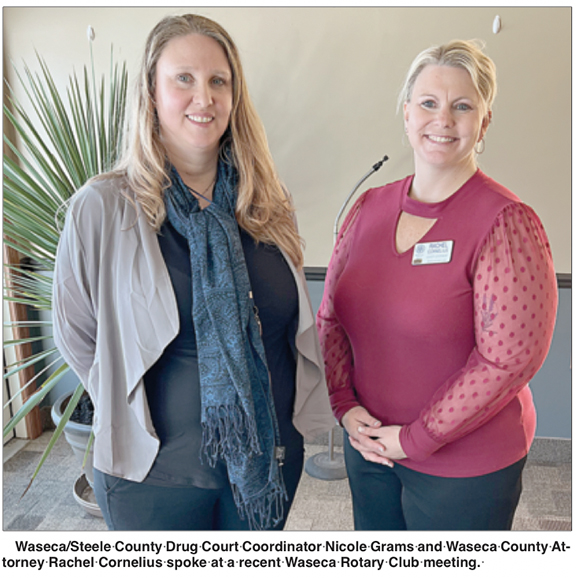 By ELI LUTGENS
By ELI LUTGENS
Publisher
The National Institutes of Health have found that inmates who leave jail or prison are not only likely to begin using drugs again upon release, they are more at risk for death by overdose than other addicts. Even if they may have been forced to “get clean” during incarceration, returning to their former social circles and circumstances often encourages them to pick up old habits.
The Waseca/Steele County “Drug Court” program focuses on helping people whose lives have included drug use to change their habits while also building resources to help them resist the temptations they will inevitably encounter.
Offenders who have been brought into the court system because of drug-related crimes–everything from drug possession or sale, DWI, or even crimes such as burglary which were motivated by a desire to get money to buy drugs–may be referred for consideration for this research-based program.
Once candidates are assessed and consent to take part, they undergo a rigorous program which is meant to help them change their outlooks and their habits.
Waseca County Attorney Rachel Cornelius and Steele-Waseca Drug Court Coordinator Nicole Grams are two members of the team which identifies likely candidates for the drug court program. The two recently shared the philosophy and facts of their service at a meeting of the Waseca Rotary Club.
“If you put people in jail, they don’t get any help for their substance use disorder. What is going to happen is that those people are going to continue to burglarize, sell drugs, victimize people in ways to do anything they can to get more money for drugs. Whereas, if we are working on the chemical dependency, and working on their criminal mindset, it is a better method to approach long-term sobriety,” explained Cornelius.
The Waseca County program serves roughly 15 participants at a time. It has so far graduated just shy of 100 people, and boasts a 75- to 80-percent success rate; that is, about that many participants are never again brought into the court system. Some numbers indicate that incarceration without treatment can lead to recidivism rates as high as 80 percent.
Participants in the drug court program are not placed in jail, but are instead remanded to a treatment system likely to last 18 months to 2 years. Under its terms, they are subject to random testing about 3 times a week. They are required to meet the expectations of any probation program they are following while also attending as many as three treatment meetings a week. They must often comply with curfew requirements, and are checked on by everyone from law enforcement and probation officers to mental health therapists.
According to Grams, the program begins by assuring participants receive mental health evaluations and have “safe, sober housing.”
The next step is to help them enter the workforce. They are expected to set short-term goals which can eventually translate into long-term progress meant to help them reenter society on stable footing. These include learning the job skills needed to stay employed, then developing a budget plan which will support reliable housing and food stability.
The process is often complicated because participants did not finish school. “It doesn’t happen overnight,” observed Grams. “Some of these folks quit school in the seventh or eighth grade.” For them, working toward their GED also becomes a goal.
Progress is rewarded with various “incentives.” On the other hand, If participants violate the terms of drug court, “disincentives” can be imposed. “Flash jail” is one such consequence–a one- to five-day incarceration meant to remind anyone who strays to stay on track.
As their lives stabilize, participants are expected to find ways to meet financial obligations such as restitution to victims and paying any drug court fines or fees. Their attention is then often turned toward getting a driver’s license.
“A lot of these people haven’t had licenses for years,” Cornelius mentioned. This doesn’t necessarily mean they haven’t been driving. “That makes them at risk,” she said. “They’re driving around without insurance; what happens if they get into an accident?
“So many things come into play. Once they work through these steps, they start to have pride in themselves.”
As they progress and begin to phase out of the program, participants are expected to become more and more self-sufficient. “We want to see how they do without us looking over their shoulders,” Grams explained. “Folks work toward a well-integrated recovery community to help with their long-term sobriety.”
